Flower gardening in the Sunshine State is more rewarding when you know which plants thrive in cool vs. warm Florida seasons. Luckily, Florida gardeners across the state have many easy-to-grow flower choices, from celosia to snapdragons. Check out our quick list of the ten best annual flowers for Florida gardens when making your garden plans. We’ve got you covered whether you’re looking for lots of colors, trailing flowers, or winter interest.

1. Celosia
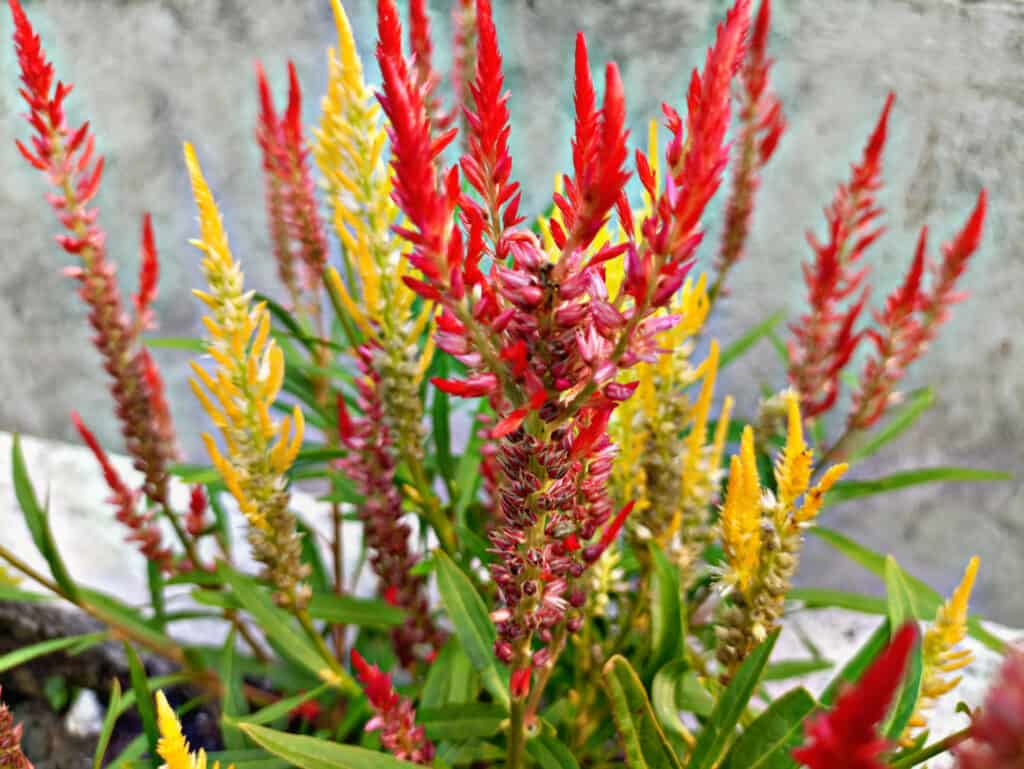
Celosia is a plant that prefers full sun.
©iStock.com/Khodar Adi Handoko
The celosia plant is drought-tolerant and loves hot summer heat, which makes this annual flower perfect for Florida gardens. This warm-weather annual flower blooms from summer until the first frost.
If you’ve never seen celosia, you’re in for a unique treat. The celosia flower looks like a plume or a feather, which is how it got its name (the Greek word for burned). The plants grow up to 3 feet tall and make wonderful cut flowers. Celosia comes in many colors, including shades of pink, red, yellow, and orange.
Quick tips for growing celosia in Florida:
-Celosia plants prefer full sun and well-drained soil.
-Water celosia regularly, especially during hot, dry periods.
-Fertilize celosia every few weeks with a balanced fertilizer.
-Give celosia plants plenty of room to grow as they can reach up to 3 feet tall at maturity.
2. Dianthus (Pink)
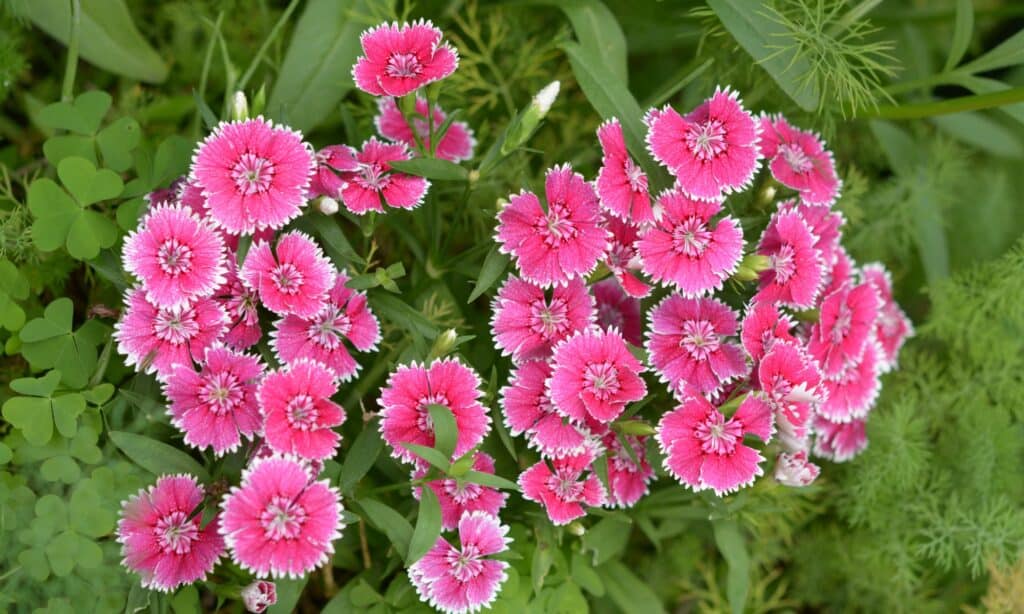
Loved for its spicy scent, dianthus plants bloom low to the ground.
©iStock.com/AnVyChicago
Dianthus is a type of flower that is part of the carnation family, but the variety featured here is called a ‘pink.’ While carnations are tall stalk flowers, dianthus plants are bushy and bloom low to the ground. And when dianthus blooms show off their bright, fringed petals, they are quite the sight to see in Florida gardens. In addition to its beauty, the dianthus plant is beloved by gardeners for its spicy vanilla scent.
The dianthus plant is a cool-weather annual flower, which means Floridians won’t see it in the summertime. Instead, Florida gardeners plant them in fall (October), so they bloom from winter through spring. Once late spring hits, dianthus takes a bow and leaves the stage.
Quick tips for growing dianthus in Florida:
-Plant pinks (dianthus) in mid-fall for winter/spring flowering.
-Dianthus prefers full sun but tolerates light shade.
-Water dianthus once a week and fertilize every 6-8 weeks with a slow-release fertilizer.
-Deadhead (remove) spent flowers to encourage more blooms and bushier growth. If you don’t deadhead these hardy plants, they will self-seed.
3. Gaillardia
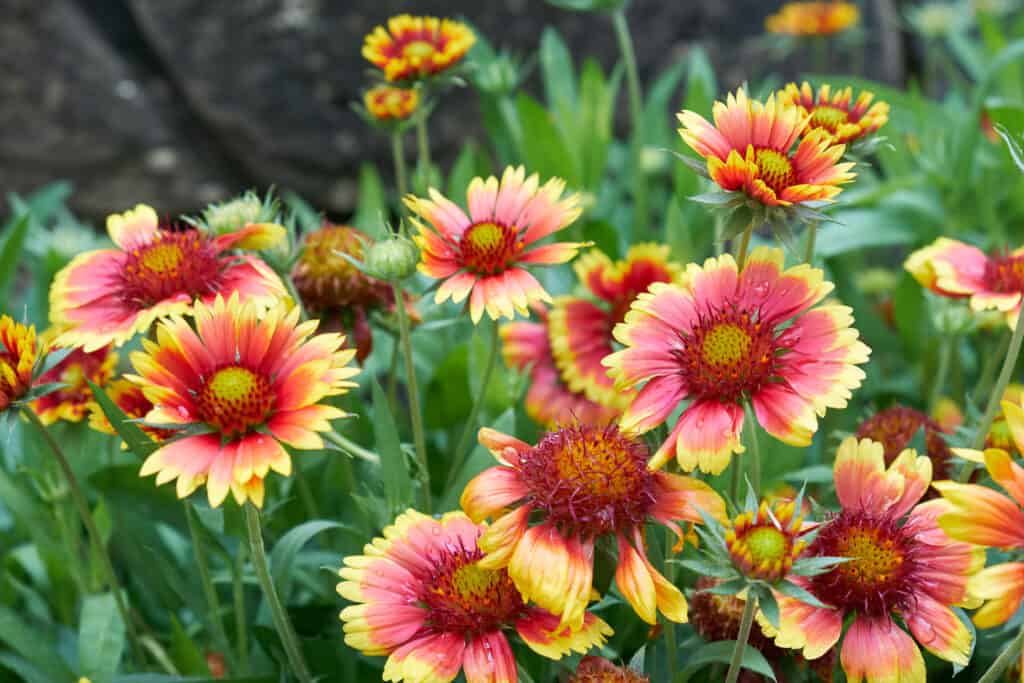
Another name for the gaillardia flower is the blanket flower.
©iStock.com/Iseo Yang
Gaillardia plants are among the best annual flowers for Florida gardens because they love high heat and sandy soil. In addition, coastal Florida gardeners appreciate that gaillardia flowers thrive in salty soil.
The gaillardia flower is called the blanket flower or cowboy’s scarf flower. It’s a cheerful, bright-colored plant that blooms from spring until fall in shades of yellow, red, and orange. Gaillardia is unique because it has ray petals (the long, thin outer petals) and disk florets (the small, tubular inner petals). Many gaillardia cultivars have yellow-tipped petals, as well.
Quick tips for growing gaillardia in Florida:
-Gaillardia prefers full sun but can tolerate some light shade.
-Water your drought-tolerant gaillardia plants once or twice a week.
-You may only need to fertilize blanket flowers at the time of planting.
-There’s no need to deadhead spent gaillardia flowers because they produce many blooms without this step. However, deadheading might keep the plants looking fuller instead of getting leggy by the end of the season.
4. Geranium
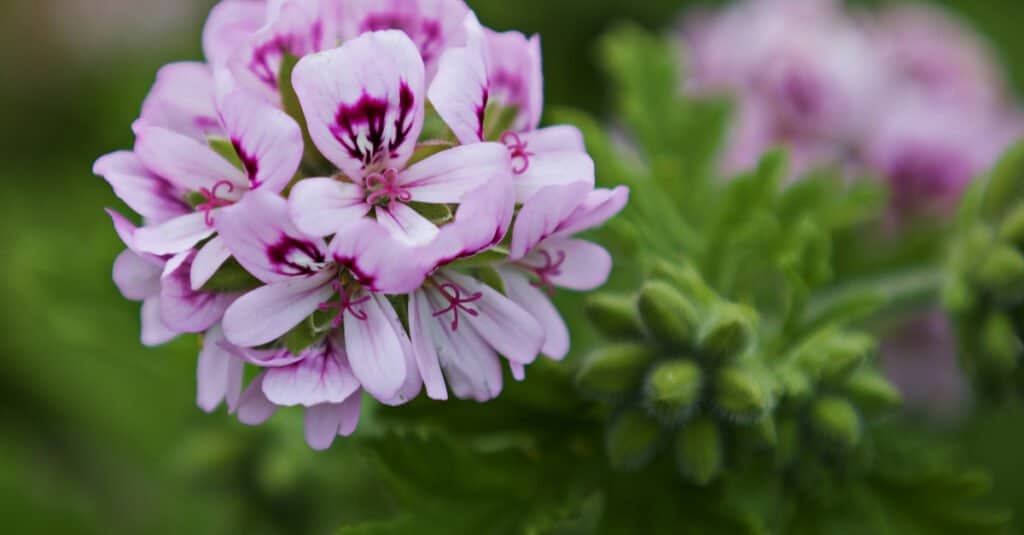
The geranium plant is easy to care for.
©tony mills/Shutterstock.com
Geraniums grow beautifully in Florida because they love warm weather and come in many colors, including pink, red, and white. However, geraniums don’t love mid to late summer Florida heat. We included geraniums on this list because of their beauty and ease of care. However, Florida gardeners should grow them differently depending on their location within the state.
- For North Florida, plant geraniums in the spring for blooms in late spring and early summer.
- For Central and South Florida, plant geraniums in mid-fall for winter blooms.
Quick tips for growing geraniums in Florida:
-Geraniums need full sun to grow their best.
-Water your geranium plants when the soil feels dry.
-Fertilize every 2-3 weeks with a water-soluble fertilizer
-Deadhead browning geranium blooms below a joint or node to encourage new growth.
5. Gerbera Daisy
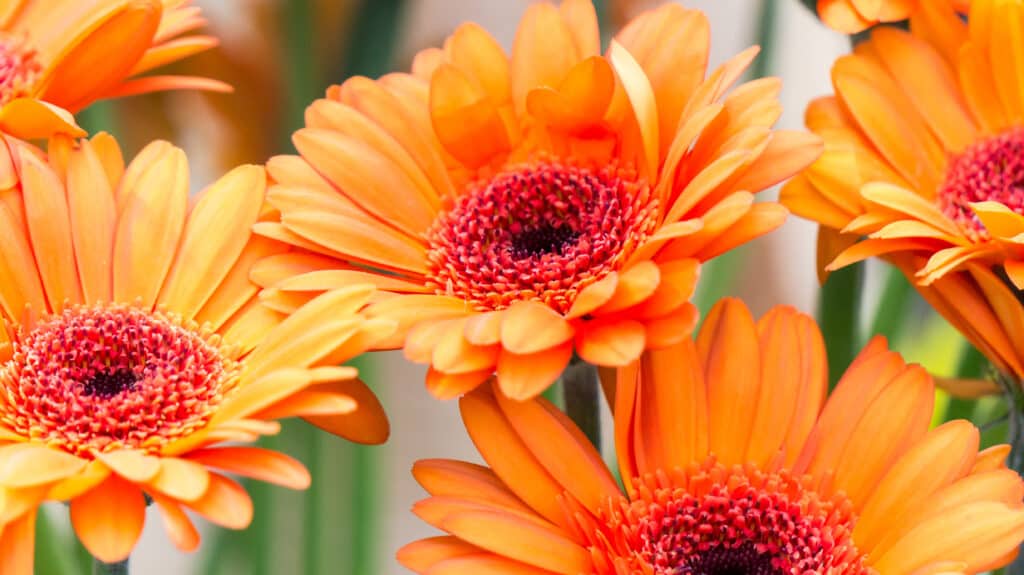
The gerbera daisy is a showy annual in Florida gardens.
©Andrey Shepetov/Shutterstock.com
Gerbera daisies are annual flowers in many growing zones, but gardeners in South Florida enjoy them year-round. In other areas of the state, the 3-4 inch bright round blooms add pretty pops of color in the spring and summer. These beautiful flowers come in shades of yellow, orange, pink, and red blooms on top of tall (up to 12 inches) stems, making them perfect for cutting and adding to bouquets.
With big blooms and large green leaves, the gerbera daisy is a showy annual flower worthy of the Florida sunshine.
Quick tips for growing gerbera daisies in Florida:
-Gerbera daisies stay healthier with full sun in the morning and a bit of shade in the afternoon.
-Water your plants when the soil feels dry at the top. Be sure the soil has good drainage, as gerbera daisies are susceptible to root rot and other fungal conditions.
-Fertilize about once a month with a complete water-soluble fertilizer or a slow-release fertilizer 2-3 times during the growing season.
-Over time, gerbera daisy plants might sink into the soil. Avoid this with regular replanting.
-Cut gerbera daisy blooms for bouquets and arrangements as needed. These flowers last a long time in vases.
6. Impatiens

Impatiens are shade-loving annual flowers.
©Jeanne Emmel/Shutterstock.com
After years of being wiped out by downy mildew, impatiens are making a big comeback as one of the best annual flowers for Florida gardens. New cultivars of traditional impatiens, New Guinea impatiens, and a hybrid called Sunpatiens, are much more resistant to mildew and are now widely available for home gardens.
The best time to plant impatiens in Florida depends on your location in the state.
- For North Florida, plant impatiens in the spring for warm weather flowering.
- For Central and South Florida, plant impatiens in mid-fall through early spring to enjoy blooms most of the year.
Impatiens are shade-loving annual flowers with long-blooming abilities. Their flowers look similar to petunias or miniature roses, depending on the cultivar. Impatiens come in white, pink, purple, orange, red, and other colors. Some varieties have bicolor blooms or variegated foliage.
Quick tips for growing impatiens in Florida:
-For North Florida, plant impatiens in spring. For Central and South Florida, plant impatiens in mid-fall through early spring.
-Impatiens love partial sun and shady areas, so feel free to plant them in containers on a covered porch.
-Water your impatiens with about 1 inch of water per week (more during hot or dry weather) but note that these plants don’t like to be soggy.
-Fertilize impatiens every two weeks for best performance through the growing season.
-Remove spent flowers to promote more blooming.
7. Lobelia
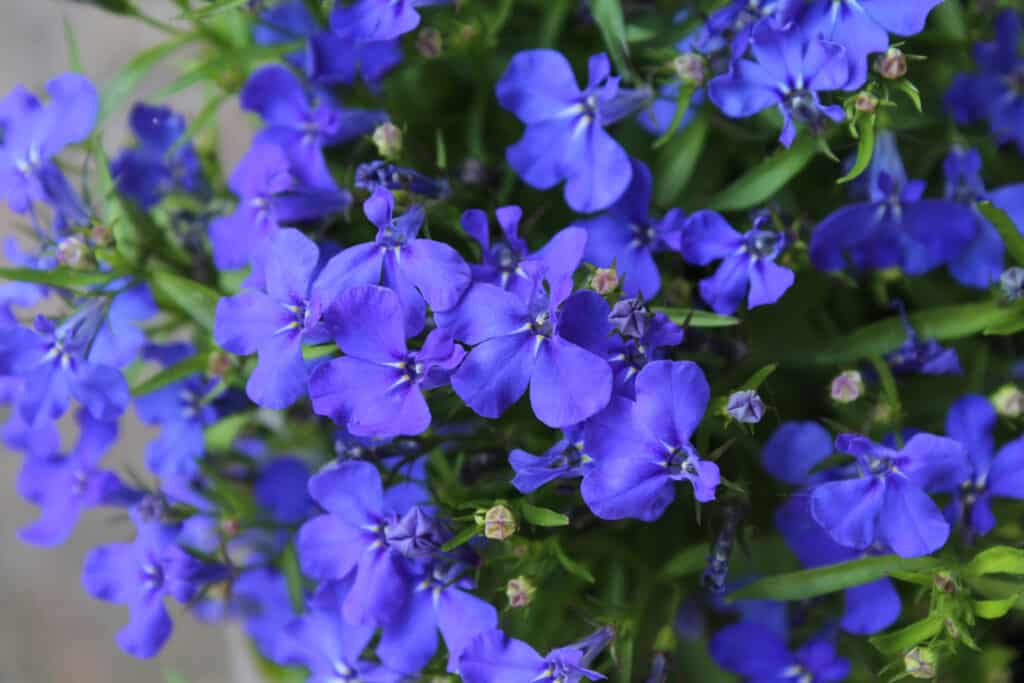
Lobelia is suited for Florida’s marshy areas.
©iStock.com/Imladris01
The traditional lobelia plant is small with bright blue blooms and one of the best annual flowers for Florida garden beds and containers. Lobelias are particularly suited for Florida’s marshy areas, as this plant loves growing in wet soil. For this reason, lobelias thrive near water features, ponds, and boggy areas.
Lobelia loves cooler weather, which means Florida gardens will have the most blooms in spring and fall or year-round in the southern regions.
Though usually recognized as a blue flower, lobelia cultivars also come in pink, white, and purple. This compact annual flower grows up to 1 foot tall with a spread of 6-12 inches.
Quick tips for growing lobelia in Florida:
-Lobelias grow best when they get 4-6 hours of sun daily.
-Water your lobelia plants when about an inch of their soil is dry. Fertilize them monthly with an all-purpose fertilizer.
-Lobelias will self-seed, so if you want more plants next season, let some blooms go to seed.
-Regularly remove spent flowers (deadhead) to keep lobelia plants full and blooming often.
8. Pansy
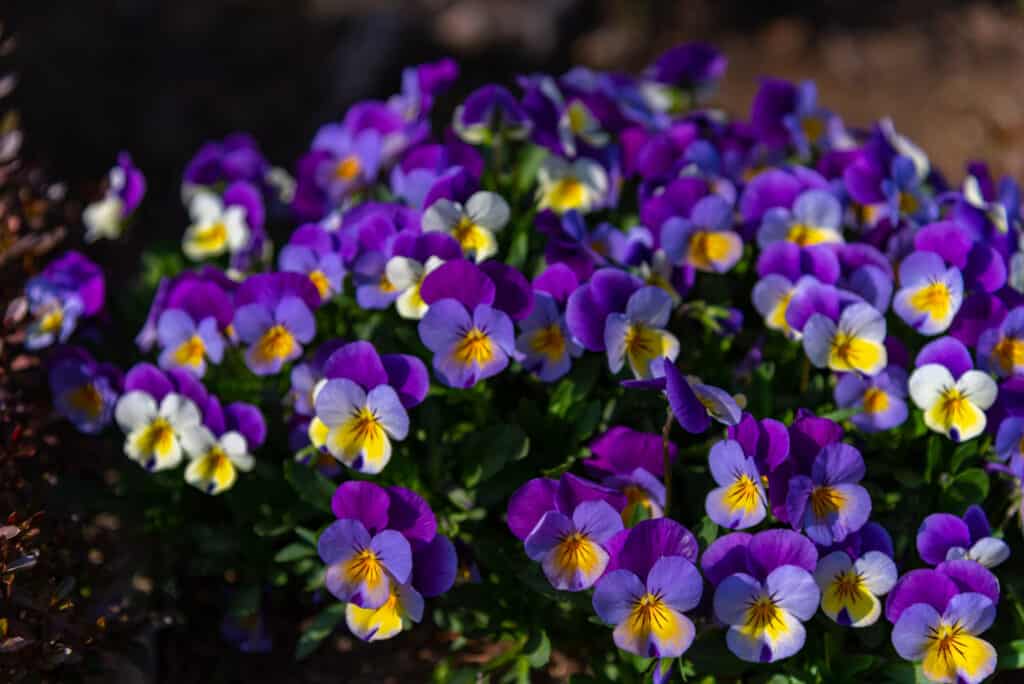
Pansy is best suited for winter planting in Florida.
©Shawn.ccf/Shutterstock.com
Pansies are one of the best annual flowers for Florida gardens because they can handle the state’s cooler temperatures in the spring and fall. However, pansies are best suited for winter planting and spring blooms in Florida. Especially in South Florida, pansies won’t bloom through the high summer heat.
Pansies come in many colors, including bi-colored blooms. They’re often used as bedding plants or for adding color to window boxes and containers.
Pansy plants have small (2-3 inch) heart-shaped flowers held above the plant on stems that range from 6-9 inches in height.
Quick tips for growing pansies in Florida:
-In Florida, plant pansies in winter for spring blooms.
-Pansies need full sun to part shade and cool temperatures to perform their best. They’ll go dormant in the heat of summer.
-Water your pansy plants about once a week. For pansies in containers, you may need to water them more than once a day in warm weather.
-Fertilize every 2-3 weeks during the growing season.
-Minimize pansy diseases with consistent deadheading (remove the wilted blooms).
9. Petunia
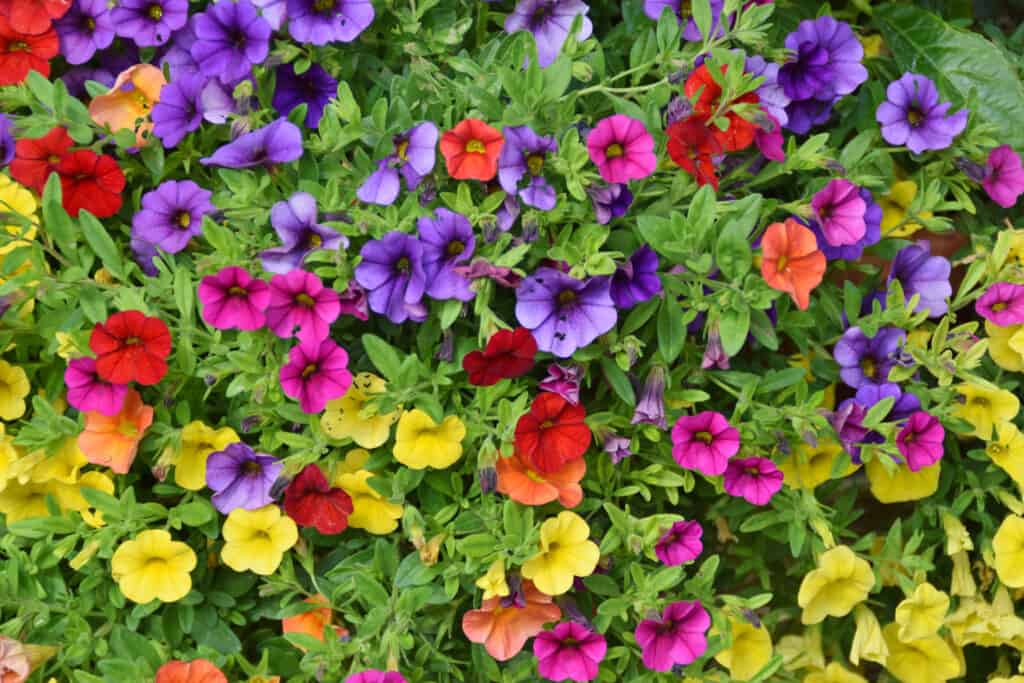
Petunias come in many colors.
©Eleonora Scordo/Shutterstock.com
Another annual flower perfect for fall planting in Florida, the petunia has long-lasting blooms and comes in many beautiful cultivars. Petunias are winter interest flowers in Florida, so enjoy these cheery flowers in garden beds and containers through the holiday season!
Petunias have trumpet-shaped blooms and come in white, pink, purple, red, and many bi-color varieties. Some cultivars are fragrant, and most will eventually trail out of their beds or containers, making them ideal flowering plants for hanging baskets and window boxes.
The varieties of size, color, petals, and length of spread among petunia cultivars can seem endless. But that means you have loads of choices when it comes to the type of petunias you want to grow each year.
Quick tips for growing petunias in Florida:
-In Florida, plant petunias in October or November for winter blooms.
-Petunias need full sun to part shade and should be watered once a week in beds or more often in containers.
-Fertilize petunias every two weeks or once a week if you’re growing spreader plants you hope will trail/creep quickly.
-Small petunia cultivars are self-cleaning plants, but the larger cultivars need their wilted blooms consistently removed (deadheaded).
10. Snapdragon
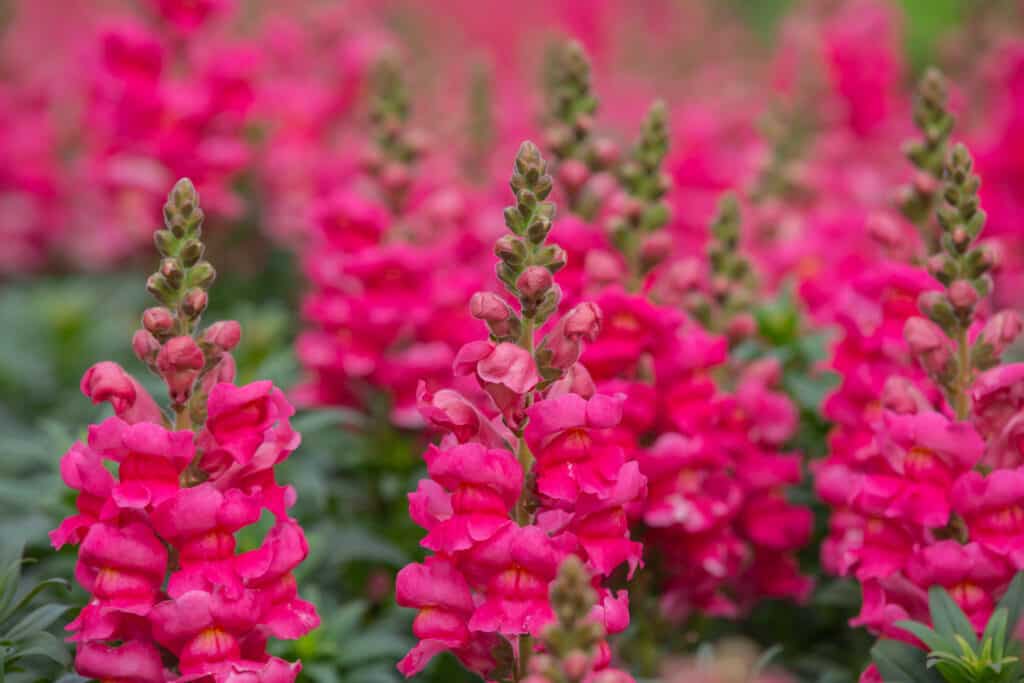
Snapdragons have petals shaped like dragon mouths.
©271 EAK MOTO/Shutterstock.com
With its showstopping fluffy spike blooms, the snapdragon is a beloved annual flower across the United States. Snapdragons in Florida provide gorgeous winter and early spring interest to garden borders, cut flower gardens, and containers in sunny spots.
Snapdragons are available in dozens of colors, including shades of yellow, orange, pink, purple, and red. The plants grow up to 3 feet tall and spread about 18 inches, making them ideal for adding height and interest as bedding plants.
Why are they called snapdragons? This showy annual flower got its name because the petals are shaped like dragon mouths that open and close when squeezed.
Quick tips for growing snapdragons in Florida:
-In Florida, plant snapdragons from October to January for winter and spring flowering.
-Snapdragons need full sun to part shade and about 1 inch of water per week.
-Once they start blooming, fertilize snapdragons every 2-4 weeks with a balanced fertilizer.
-Remove spent blooms to encourage snapdragons to bloom again.
The Best Annual Flowers for Florida Make Gulf State Gardens Shine!
Planting annual flowers in Florida gardens takes a bit of planning for cool weather vs. warm weather blooms. Still, the flowers on our list should be easy to maintain for gardeners of all levels. We hope this list of the ten best annual flowers for Florida helps make gardening easy and satisfying for years to come!
Summary Of The 10 Best Annual Flowers For Florida Gardens
| Rank | Annual Flower |
|---|---|
| 1 | Celosia |
| 2 | Dianthus (Pink) |
| 3 | Gaillardia |
| 4 | Geranium |
| 5 | Gerbera Daisy |
| 6 | Impatiens |
| 7 | Lobelia |
| 8 | Pansy |
| 9 | Petunia |
| 10 | Snapdragon |
The photo featured at the top of this post is © iStock.com/Imladris01
Thank you for reading! Have some feedback for us? Contact the AZ Animals editorial team.







